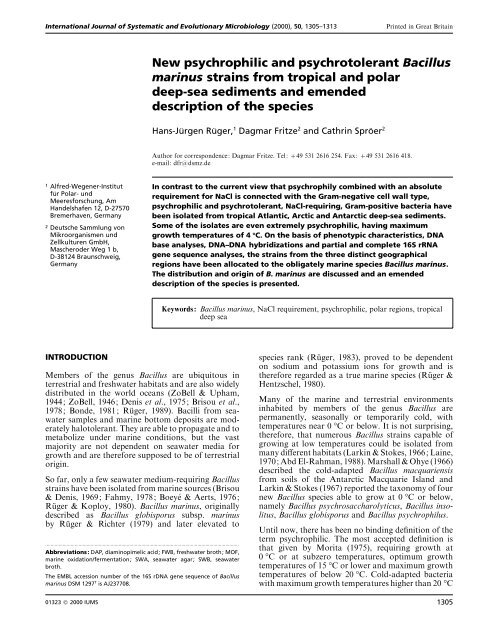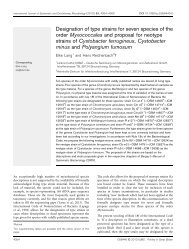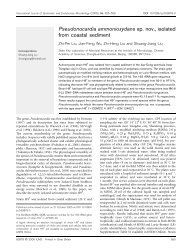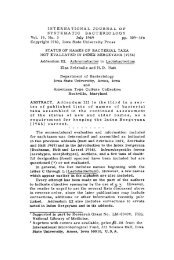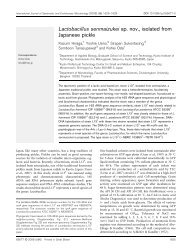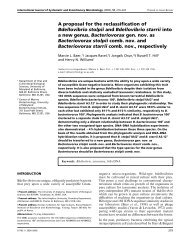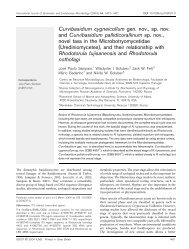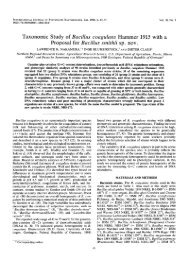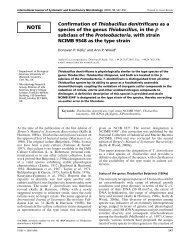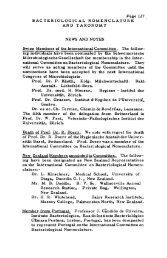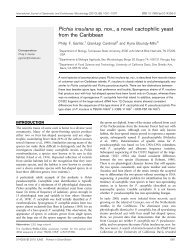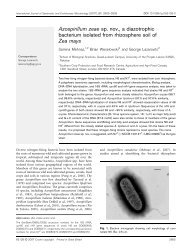New psychrophilic and psychrotolerant Bacillus marinus strains from ...
New psychrophilic and psychrotolerant Bacillus marinus strains from ...
New psychrophilic and psychrotolerant Bacillus marinus strains from ...
Create successful ePaper yourself
Turn your PDF publications into a flip-book with our unique Google optimized e-Paper software.
International Journal of Systematic <strong>and</strong> Evolutionary Microbiology (2000), 50, 1305–1313 Printed in Great Britain<br />
1 Alfred-Wegener-Institut<br />
fu r Polar- und<br />
Meeresforschung, Am<br />
H<strong>and</strong>elshafen 12, D-27570<br />
Bremerhaven, Germany<br />
2 Deutsche Sammlung von<br />
Mikroorganismen und<br />
Zellkulturen GmbH,<br />
Mascheroder Weg 1 b,<br />
D-38124 Braunschweig,<br />
Germany<br />
INTRODUCTION<br />
Members of the genus <strong>Bacillus</strong> are ubiquitous in<br />
terrestrial <strong>and</strong> freshwater habitats <strong>and</strong> are also widely<br />
distributed in the world oceans (ZoBell & Upham,<br />
1944; ZoBell, 1946; Denis et al., 1975; Brisou et al.,<br />
1978; Bonde, 1981; Ru ger, 1989). Bacilli <strong>from</strong> seawater<br />
samples <strong>and</strong> marine bottom deposits are moderately<br />
halotolerant. They are able to propagate <strong>and</strong> to<br />
metabolize under marine conditions, but the vast<br />
majority are not dependent on seawater media for<br />
growth <strong>and</strong> are therefore supposed to be of terrestrial<br />
origin.<br />
So far, only a few seawater medium-requiring <strong>Bacillus</strong><br />
<strong>strains</strong> have been isolated <strong>from</strong> marine sources (Brisou<br />
& Denis, 1969; Fahmy, 1978; Boeye & Aerts, 1976;<br />
Ru ger & Koploy, 1980). <strong>Bacillus</strong> <strong>marinus</strong>, originally<br />
described as <strong>Bacillus</strong> globisporus subsp. <strong>marinus</strong><br />
by Ru ger & Richter (1979) <strong>and</strong> later elevated to<br />
.................................................................................................................................................<br />
Abbreviations : DAP, diaminopimelic acid; FWB, freshwater broth; MOF,<br />
marine oxidation/fermentation; SWA, seawater agar; SWB, seawater<br />
broth.<br />
The EMBL accession number of the 16S rDNA gene sequence of <strong>Bacillus</strong><br />
<strong>marinus</strong> DSM 1297T is AJ237708.<br />
<strong>New</strong> <strong>psychrophilic</strong> <strong>and</strong> <strong>psychrotolerant</strong> <strong>Bacillus</strong><br />
<strong>marinus</strong> <strong>strains</strong> <strong>from</strong> tropical <strong>and</strong> polar<br />
deep-sea sediments <strong>and</strong> emended<br />
description of the species<br />
Hans-Ju rgen Ru ger, 1 Dagmar Fritze 2 <strong>and</strong> Cathrin Spro er 2<br />
Author for correspondence: Dagmar Fritze. Tel: 49 531 2616 254. Fax: 49 531 2616 418.<br />
e-mail: dfrdsmz.de<br />
In contrast to the current view that psychrophily combined with an absolute<br />
requirement for NaCl is connected with the Gram-negative cell wall type,<br />
<strong>psychrophilic</strong> <strong>and</strong> <strong>psychrotolerant</strong>, NaCl-requiring, Gram-positive bacteria have<br />
been isolated <strong>from</strong> tropical Atlantic, Arctic <strong>and</strong> Antarctic deep-sea sediments.<br />
Some of the isolates are even extremely <strong>psychrophilic</strong>, having maximum<br />
growth temperatures of 4 SC. On the basis of phenotypic characteristics, DNA<br />
base analyses, DNA–DNA hybridizations <strong>and</strong> partial <strong>and</strong> complete 16S rRNA<br />
gene sequence analyses, the <strong>strains</strong> <strong>from</strong> the three distinct geographical<br />
regions have been allocated to the obligately marine species <strong>Bacillus</strong> <strong>marinus</strong>.<br />
The distribution <strong>and</strong> origin of B. <strong>marinus</strong> are discussed <strong>and</strong> an emended<br />
description of the species is presented.<br />
Keywords: <strong>Bacillus</strong> <strong>marinus</strong>, NaCl requirement, <strong>psychrophilic</strong>, polar regions, tropical<br />
deep sea<br />
species rank (Ru ger, 1983), proved to be dependent<br />
on sodium <strong>and</strong> potassium ions for growth <strong>and</strong> is<br />
therefore regarded as a true marine species (Ru ger &<br />
Hentzschel, 1980).<br />
Many of the marine <strong>and</strong> terrestrial environments<br />
inhabited by members of the genus <strong>Bacillus</strong> are<br />
permanently, seasonally or temporarily cold, with<br />
temperatures near 0 C or below. It is not surprising,<br />
therefore, that numerous <strong>Bacillus</strong> <strong>strains</strong> capable of<br />
growing at low temperatures could be isolated <strong>from</strong><br />
many different habitats (Larkin & Stokes, 1966; Laine,<br />
1970; Abd El-Rahman, 1988). Marshall & Ohye (1966)<br />
described the cold-adapted <strong>Bacillus</strong> macquariensis<br />
<strong>from</strong> soils of the Antarctic Macquarie Isl<strong>and</strong> <strong>and</strong><br />
Larkin & Stokes (1967) reported the taxonomy of four<br />
new <strong>Bacillus</strong> species able to grow at 0 C or below,<br />
namely <strong>Bacillus</strong> psychrosaccharolyticus, <strong>Bacillus</strong> insolitus,<br />
<strong>Bacillus</strong> globisporus <strong>and</strong> <strong>Bacillus</strong> psychrophilus.<br />
Until now, there has been no binding definition of the<br />
term <strong>psychrophilic</strong>. The most accepted definition is<br />
that given by Morita (1975), requiring growth at<br />
0 C or at subzero temperatures, optimum growth<br />
temperatures of 15 C or lower <strong>and</strong> maximum growth<br />
temperatures of below 20 C. Cold-adapted bacteria<br />
with maximum growth temperatures higher than 20 C<br />
01323 2000 IUMS 1305
H.-J. Ru ger, D. Fritze <strong>and</strong> C. Spro er<br />
are regarded as ‘psychrotrophic’ (Baross & Morita,<br />
1978). In accordance with these definitions, all the<br />
cold-adapted bacilli mentioned above are therefore<br />
‘psychrotrophic’, including those <strong>strains</strong> that were<br />
originally characterized as <strong>psychrophilic</strong>.<br />
Instead of ‘psychrotrophic’, which means ‘cold-eating’,<br />
the term <strong>psychrotolerant</strong> seems to be more logical<br />
for organisms normally growing at temperatures above<br />
20 C, but also being able to grow at near 0 C or<br />
below (Russell, 1993; Nedwell & Rutter, 1994). Therefore,<br />
the term <strong>psychrotolerant</strong> is preferred in this<br />
paper.<br />
In contrast to the current view, that strict psychrophily<br />
plus an absolute requirement for NaCl is connected<br />
with the Gram-negative cell wall type, Ru ger & Tan<br />
(1992) reported the isolation of <strong>psychrophilic</strong>,<br />
seawater-requiring, Gram-positive bacteria <strong>from</strong> the<br />
permanently cold deep-sea floor of the eastern tropical<br />
Atlantic. During two subsequent expeditions in 1987<br />
<strong>and</strong> 1990, aerobic spore-forming bacteria with the<br />
same phenotypic characteristics as the tropical deepsea<br />
<strong>strains</strong> have been isolated <strong>from</strong> Arctic <strong>and</strong> Antarctic<br />
bottom sediments. On the basis of DNA base<br />
analyses, DNA–DNA hybridizations <strong>and</strong> 16S rRNA<br />
gene sequencing, the <strong>strains</strong> <strong>from</strong> these three distinct<br />
geographical regions have been allocated to B.<br />
<strong>marinus</strong>. The distribution <strong>and</strong> origin of this species are<br />
discussed <strong>and</strong> an emended description of B. <strong>marinus</strong><br />
is presented, incorporating the phenotypic characteristics<br />
of the new isolates.<br />
METHODS<br />
Isolation of <strong>strains</strong>. The bacteria listed in Table 1 were<br />
isolated <strong>from</strong> sediment samples during the expedition<br />
GEOTROPEX ’83 with the German research vessel Meteor<br />
in the eastern tropical Atlantic in 1983 <strong>and</strong> during two<br />
expeditions with the German research vessel Polarstern in<br />
1987 <strong>and</strong> 1990 in the Arctic <strong>and</strong> Antarctic seas, respectively.<br />
The geographical positions of sampling sites <strong>and</strong> the<br />
corrected depths were taken <strong>from</strong> Sarnthein et al. (1983),<br />
Tan & Ru ger (1991) <strong>and</strong> Tan et al. (1999).<br />
Sediment sample processing <strong>and</strong> isolation of <strong>strains</strong> were<br />
done as described previously (Ru ger & Tan, 1992). All<br />
solutions <strong>and</strong> agar media were pre-chilled to 4 C <strong>and</strong> held at<br />
this temperature on a cold tray during the whole inoculation<br />
procedure. Seawater agar (SWA) according to ZoBell (1946)<br />
was used as isolation medium, but was modified <strong>and</strong><br />
consisted of 15 g Bacto Peptone, 03 g yeast extract, 001 g<br />
FePO 4H O, 100 g Agar no. 1 (Oxoid), 750 ml seawater<br />
<strong>and</strong><br />
<br />
250 ml<br />
<br />
distilled water; pH 76. The incubation<br />
temperatures were 2 <strong>and</strong> 20 C for the tropical <strong>strains</strong> <strong>and</strong><br />
4 C for the polar <strong>strains</strong>. For isolation of <strong>Bacillus</strong> <strong>strains</strong><br />
<strong>from</strong> dormant spores (<strong>strains</strong> A02712, A02720, A02800,<br />
A02819, A02735, A02736 <strong>and</strong> A02738), dilutions of sediment<br />
subsamples were heated for 10 min at 80 <strong>and</strong> 90 C <strong>and</strong><br />
spread onto spore germination medium II (Ru ger, 1975).<br />
Spore formation. The ability to form endospores was<br />
determined in the following test media: SWA, SWA with<br />
the addition of 1538 mg MnSO H O l− <strong>and</strong> 1538 mg<br />
CaCl 2H Ol− <strong>and</strong> in seawater broth (SWB) supplemented<br />
with 18 mM (final concentration) decoyinine, psicofuranine<br />
or psicofuranine tetraacetate (Zain-ul-Abedin et al.,<br />
1983; Ru ger & Tan, 1992). Evaluation of spore formation<br />
was done microscopically after 4 <strong>and</strong> 8 weeks incubation at<br />
4 C. The composition of SWB is given below.<br />
Physiological characterization of <strong>strains</strong>. The tests for identification<br />
of <strong>strains</strong> were performed in seawater media as<br />
described previously (Ru ger & Richter, 1979; Ru ger &<br />
Ho fle, 1992). Test temperatures were 4 C; only the 20 C<br />
isolates A03029, A03051 <strong>and</strong> A03126 were tested at 20 C.<br />
Fermentation of carbohydrates was determined with the<br />
Minitek identification system after 2, 4, 7 <strong>and</strong> 14 d incubation<br />
(Ru ger, 1981). Fermentation of glucose was additionally<br />
tested in the marine oxidationfermentation<br />
(MOF) medium developed by Leifson (1963).<br />
Susceptibility to antibiotics was determined with Oxoid<br />
disks loaded with the various amounts of antibiotics given,<br />
placed on agar plates prepared with 10 ml SWA.<br />
Utilization of organic compounds as sole sources of carbon<br />
<strong>and</strong> energy was studied in st<strong>and</strong>ard microtitre plates by<br />
means of a multipoint inoculator (Ru ger, 1988). In order to<br />
detect possible cross-contamination, three neighbouring<br />
wells were taken for each strain. Turbidity was used as an<br />
indicator for substrate utilization <strong>and</strong> was measured with a<br />
microtitre plate photometer at 405 nm after 2, 4, 6 <strong>and</strong> 8<br />
weeks incubation. An increase in turbidity of more than 01<br />
OD unit was considered a positive result.<br />
The composition of the cell walls, i.e. the presenceabsence<br />
of diaminopimelic acid (DAP), was evaluated following the<br />
method described by K<strong>and</strong>ler & Weiss (1986).<br />
Growth characteristics of <strong>strains</strong>. Optimal <strong>and</strong> maximal<br />
growth temperatures of the tropical isolates were determined<br />
at 4, 12, 18, 24, 30 <strong>and</strong> 37 C in SWB, consisting of 50 g<br />
Bacto Peptone, 10 g yeast extract, 001 g FePO 4H O, 750<br />
<br />
ml seawater <strong>and</strong> 250 ml distilled water; pH 76. Growth was<br />
measured by monitoring optical density at 650 nm with a<br />
Gilford photometer model 250. For the polar isolates, the<br />
microtitre plate method as described above was used with<br />
the same seawater medium, but with incubation temperatures<br />
of 1, 4, 8, 12, 18, 24, 30 <strong>and</strong> 37 C for the Arctic <strong>strains</strong><br />
<strong>and</strong> 1, 4, 8, 12, 16, 20, 24, 30 <strong>and</strong> 37 C for the Antarctic<br />
<strong>strains</strong>. Turbidity measurements were performed after 3, 7<br />
<strong>and</strong> 14 d incubation <strong>and</strong> turbidity increases of 01 OD unit<br />
were taken as positive results.<br />
The microtitre plate method was also applied to determine<br />
the NaCl requirements of the <strong>strains</strong>. The basic test medium,<br />
supplemented with 1 ml of a vitamin stock solution l−<br />
(Ru ger, 1988), has been described previously (Ru ger &<br />
Hentzschel, 1980). Growth was tested at the following NaCl<br />
concentrations: 0, 25, 100, 200, 300, 400, 600, 800, 1000,<br />
1500, 2000, 2500 <strong>and</strong> 3000 mM. Turbidity was measured<br />
after 1, 3, 7, 14 <strong>and</strong> 21 d incubation at 4 <strong>and</strong> 20 C.<br />
Seawater requirements of the <strong>strains</strong> were tested by comparing<br />
growth in SWB <strong>and</strong> freshwater broth (FWB),<br />
containing the same constituents as SWB but prepared with<br />
distilled water.<br />
Interpretation of the test results for growth temperatures<br />
<strong>and</strong> NaCl requirements. A maximum growth temperature of<br />
24 C, for instance, means that growth occurred at 24 C<br />
but not at the next higher temperature tested. Thus, the real<br />
maximum is somewhere between 24 <strong>and</strong> 30 C. Similarly, a<br />
1306 International Journal of Systematic <strong>and</strong> Evolutionary Microbiology 50
B. <strong>marinus</strong> <strong>from</strong> tropical <strong>and</strong> polar deep-sea sediments<br />
Table 1. Strains used in this study<br />
.................................................................................................................................................................................................................................................................................................................<br />
Agar plates for isolation of <strong>strains</strong> were incubated at 2 C (tropical isolates) or 4 C (polar isolates). Exceptions were <strong>strains</strong><br />
A03029, A03051 <strong>and</strong> A03126, isolated <strong>from</strong> agar plates incubated at 20 C. Strains were isolated on the following expeditions:<br />
GEOTROPEX ’83, 1983 (tropical Atlantic), ARK IV2, 1987 (Arctic Ocean) <strong>and</strong> ANT VIII6, 1990 (Antarctic Ocean).<br />
Strain Sampling site Depth (m) Sediment<br />
layer (cm)<br />
Station Latitude Longitude<br />
Tropical Atlantic<br />
A02605 (DSM 12258) 373 09 143 N 19377 W 4694 4–6<br />
A02685 (DSM 12323), A02712, A02720, A02735,<br />
A02736, A02738<br />
381 05 370 N 19589 W 2811 0–2<br />
A02761, A02766, A02767 (DSM 11891), A02788,<br />
A02800<br />
381 05 370 N 19589 W 2811 4–6<br />
A02819 (DSM 11894) 383 02 598 N 22025 W 4514 0–2<br />
A02827 388 16 562 N 17555 W 2766 0–2<br />
A03029 (DSM 11898) 371 09 553 N 17528 W 1507 4–6<br />
A03051 (DSM 11899) 373 09 143 N 19377 W 4694 4–6<br />
A03126 (DSM 12259)<br />
Arctic Ocean<br />
376 09 082 N 19018 W 4802 4–6<br />
AR3353 (DSM 12296) 11223 75 333 N 08488 W 2629 0–2<br />
AR3393 (DSM 11895), AR3396 (DSM 11892),<br />
AR3398 (DSM 11893)<br />
11235 75 094 N 12276 W 403 0–2<br />
AR3447<br />
Antarctic Ocean<br />
11248 72 134 N 16043 W 1450 0–2<br />
GU4214 (DSM 12359) 16516 66 037 S 33166 E 1357 0–2<br />
GU4223 (DSM 12356), GU4227, GU4233 (DSM<br />
11896), GU4234 (DSM 11897)<br />
Reference strain<br />
B. <strong>marinus</strong> DSM 1297T (ATCC 29841T)<br />
16518 64 573 S 33377 E 2225 0–2<br />
maximum NaCl concentration of 1000 mM means growth<br />
at 1000 mM but not at the next higher concentration tested,<br />
<strong>and</strong> a minimum of 100 mM means growth at 100 mM but<br />
not at the next lower concentration, of 25 mM.<br />
DNA base composition. The GC content of the DNA was<br />
determined <strong>from</strong> the thermal denaturation profile (Marmur<br />
& Doty, 1962), obtained with a Gilford model 250 spectrophotometer<br />
equipped with a Gilford model 2527 thermoprogrammer<br />
<strong>and</strong> calculated by using the equation of De Ley<br />
(1970). DNA <strong>from</strong> Escherichia coli K-12 was used as a<br />
reference. GC ratios were determined <strong>from</strong> nine melting<br />
curves per strain.<br />
DNA–DNA hybridization. DNA–DNA relatedness was determined<br />
<strong>from</strong> renaturation rates according to the protocol<br />
given by Fritze et al. (1990), based on the methods reported<br />
by De Ley et al. (1970) <strong>and</strong> Gillis et al. (1970).<br />
For hybridizations with the type strain of B. <strong>marinus</strong>, DNA<br />
preparation was done according to Cashion et al. (1977).<br />
Renaturation rates of these analyses were calculated using<br />
the transfer.bas computer program of Jahnke (1992).<br />
16S rDNA sequence determination <strong>and</strong> analysis. Genomic<br />
DNA extraction, PCR-mediated amplification of 16S rDNA<br />
<strong>and</strong> sequencing of the PCR products were as described by<br />
Rainey et al. (1996). The sequence reaction products were<br />
electrophoresed using an Applied Biosystems 373A DNA<br />
sequencer. The 16S rDNA sequences were aligned manually<br />
with members of <strong>Bacillus</strong> rRNA group 2 using the ae2 editor<br />
(Maidak et al., 1996). Evolutionary distances were calculated<br />
by the method of Jukes & Cantor (1969). Phylogenetic<br />
dendrograms were constructed using the treeing algorithm<br />
of De Soete (1983).<br />
RESULTS<br />
Growth temperatures <strong>and</strong> NaCl requirements<br />
From tropical deep-sea sediments, 131 <strong>Bacillus</strong> <strong>strains</strong><br />
were isolated <strong>from</strong> plates incubated at 2 C <strong>and</strong> 147<br />
<strong>from</strong> plates incubated at 20 C. In contrast to the<br />
latter, the majority of the 2 C <strong>strains</strong> required seawater<br />
media for growth, were <strong>psychrophilic</strong> or<br />
<strong>psychrotolerant</strong> (Table 2) <strong>and</strong> had almost identical<br />
phenotypic characteristics (Ru ger & Tan, 1992).<br />
Twenty-one taxonomically <strong>and</strong> physiologically comparable<br />
<strong>Bacillus</strong> <strong>strains</strong> were isolated <strong>from</strong> Arctic<br />
sediment samples <strong>and</strong> 41 <strong>from</strong> Antarctic sediment<br />
samples.<br />
Besides testing the seawater requirements of all 340<br />
isolates by comparing growth in SWB <strong>and</strong> in FWB, the<br />
minimum, optimum <strong>and</strong> maximum NaCl concentrations<br />
for growth were additionally determined for<br />
the 27 <strong>strains</strong> chosen as representative of all <strong>strains</strong>.<br />
The NaCl requirements of the <strong>strains</strong> in relation to<br />
their growth temperatures are compiled in Table 2. All<br />
International Journal of Systematic <strong>and</strong> Evolutionary Microbiology 50 1307
H.-J. Ru ger, D. Fritze <strong>and</strong> C. Spro er<br />
Table 2. Growth temperatures <strong>and</strong> NaCl requirements of B. <strong>marinus</strong> <strong>strains</strong><br />
.................................................................................................................................................................................................................................................................................................................<br />
All <strong>strains</strong> were able to grow at the lowest temperatures tested, namely 1 C for the polar isolates, the isolation temperature of<br />
2 C for the tropical deep-sea <strong>strains</strong> <strong>and</strong> 4 C for the three 20 C isolates A03029, A03051 <strong>and</strong> A03126. ng, No growth.<br />
Strain Growth temperature (SC) NaCl requirement (mM) at 4 SC<br />
Optimum Maximum Minimum Optimum Maximum<br />
Tropical Atlantic<br />
A02605 18–24 24 0 300–400 1000<br />
A02685 4 12 200 300 400<br />
A02712 4 18 100 300–400 800<br />
A02720 4 12 200 200–300 400<br />
A02735 12 18 100 200–400 800<br />
A02736 12 18 200 400 800<br />
A02738 12 18 300 300 600<br />
A02761 4 12 100 400 600<br />
A02766 12 24 200 300 800<br />
A02767 4 4 100 200 400<br />
A02788 12 24 100 300–400 1000<br />
A02800 4 4 100 300 800<br />
A02819 4–12 24 100 200–300 800<br />
A02827 12 24 25 200–300 1000<br />
A03029 12–24 24 25 300–400 1500<br />
A03051 12–24 30 100 300–400 1000<br />
A03126 12–24 24 100 400 1000<br />
Arctic Ocean<br />
AR3353 4 12 200 300–400 1000<br />
AR3393 8 12 100 300–600 1000<br />
AR3396 4 12 100 300 800<br />
AR3398 1–4 4 200 300–400 1000<br />
AR3447 8–12 12 ng ng ng<br />
Antarctic Ocean<br />
GU4214 8–12 16 100 300–400 1000<br />
GU4223 8 16 100 200–300 600<br />
GU4227 8 12 200 300–400 800<br />
GU4233 8 16 100 200–400 800<br />
GU4234 8–12 20 100 200–400 1000<br />
<strong>strains</strong> except A02605 required at least 25 or 100 mM<br />
NaCl for growth. The optimum concentrations of<br />
200–400 mM correspond to 12–24% NaCl, approximately<br />
the natural NaCl concentration of seawater. In<br />
comparison with SWB, the synthetic medium used in<br />
the NaCl requirement tests seemed to be suboptimal.<br />
Strain A02819, for instance, still showed slight growth<br />
at 24 C in SWB, but failed to grow at 20 C in the salt<br />
test (result not presented in Table 2), <strong>and</strong> the <strong>psychrophilic</strong><br />
strain AR3447 did not grow in the salt test even<br />
at 4 C.<br />
Morphological <strong>and</strong> physiological characterization<br />
Cell morphology <strong>and</strong> colony form details are given<br />
below in the emended description of B. <strong>marinus</strong>. Not<br />
all <strong>strains</strong> were motile; only 12 of the 27 <strong>strains</strong> formed<br />
endospores <strong>and</strong> in eight other <strong>strains</strong>, spore formation<br />
was questionable (Table 3). Additional sporulation<br />
could not be induced by the use of media containing<br />
decoyinine, psicofuranine or psicofuranine tetraacetate.<br />
Biochemical <strong>and</strong> nutritional characters for which all<br />
<strong>strains</strong> were positive or negative are also given in the<br />
emended species description. Characteristics for which<br />
there were strain differences are listed in Table 3.<br />
Fermentation of carbohydrates was tested with the<br />
Minitek system. For glucose, the MOF medium of<br />
Leifson (1963) was additionally used. All <strong>strains</strong><br />
produced acid <strong>from</strong> glucose in the MOF medium, but<br />
only the Arctic <strong>and</strong> Antarctic isolates gave positive<br />
results with the Minitek system. There is no reasonable<br />
explanation for the differences in carbohydrate fermentation<br />
results obtained with these two methods,<br />
since the Minitek system proved to be useful for the<br />
differentiation of marine bacteria in a comparative<br />
study (Ru ger, 1981). The polar <strong>strains</strong> seem to be more<br />
active than the tropical isolates, as can be seen <strong>from</strong> the<br />
1308 International Journal of Systematic <strong>and</strong> Evolutionary Microbiology 50
B. <strong>marinus</strong> <strong>from</strong> tropical <strong>and</strong> polar deep-sea sediments<br />
Table 3. Phenotypic characteristics that differ among B. <strong>marinus</strong> <strong>strains</strong><br />
.................................................................................................................................................................................................................................................................................................................<br />
Strains are identified as: Ref, DSM 1297T; 1, A02605; 2, A02685; 3, A02712; 4, A02720; 5, A02735; 6, A02736; 7, A02738; 8,<br />
A02761; 9, A02766; 10, A02767; 11, A02788; 12, A02800; 13, A02819; 14, A02827; 15, A03029; 16, A03051; 17, A03126; 18,<br />
AR3353; 19, AR3393; 20, AR3396; 21, AR3398; 22, AR3447; 23, GU4214; 24, GU4223; 25, GU4227; 26, GU4233; <strong>and</strong> 27,<br />
GU4234. Characteristics are scored as: , positive; (), weakly positive; (), very weak positive reaction; , negative; ?,<br />
formation of endospores questionable; nt, not tested. Characteristics of strain DSM 1297T, the type strain of B. <strong>marinus</strong>, were<br />
taken <strong>from</strong> Ru ger & Richter (1979) <strong>and</strong> Ru ger (1983).<br />
Characteristic Tropical Atlantic Arctic Ocean Antarctic Ocean<br />
2 SC Isolates 20 SC Isolates<br />
Ref 1 2 3 4 5 6 7 8 9 10 11 12 13 14 15 16 17 18 19 20 21 22 23 24 25 26 27<br />
Motility nt <br />
Spore formation ? ? ? ? ? ? ? ? <br />
Oxidase (Kovacs) () () () () () () () () () <br />
Indophenol oxidase () () () () () () () () () () () () () ()<br />
Catalase () () () () <br />
β-Galactosidase (ONPG method) nt nt nt nt nt nt nt nt () <br />
β-Glucosidase nt () () () nt nt nt nt nt nt nt nt nt nt nt nt nt<br />
DNase nt () () () () () <br />
Lecithinase nt () nt nt nt nt nt nt nt nt nt nt<br />
Urease () () () () <br />
Aesculin hydrolysis () () () () <br />
Nitrate reduction to nitrite () <br />
Gelatin hydrolysis () () () () <br />
Casein hydrolysis nt nt nt nt nt nt nt nt nt nt<br />
H S production <strong>from</strong> cysteine () () () () () () () () () ()<br />
Susceptibility to:<br />
Pteridine 0129, 10 µg () <br />
Acid <strong>from</strong> (Minitek system):<br />
Glucose () <br />
Glycerol () () () () () () () () <br />
Maltose () () <br />
Mannose () () () () () <br />
Trehalose () <br />
Xylose <br />
oxidase, β-galactosidase, aesculin, gelatin <strong>and</strong> mannose<br />
test results.<br />
Presence/absence of DAP<br />
One-dimensional TLC of whole-cell lysates revealed<br />
the absence of DAP <strong>from</strong> the cell walls of the<br />
representative strain A02819 (DSM 11894). Previous<br />
analysis of the type strain, B. <strong>marinus</strong> DSM<br />
1297T, had shown that the peptide side chains of the<br />
peptidoglycan are linked directly through l-lysine,<br />
which carries a glycine bound to the carboxyl group<br />
(N. Weiß, personal communication).<br />
DNA base composition <strong>and</strong> DNA–DNA homology<br />
The DNA base composition was determined for 16<br />
<strong>strains</strong> <strong>and</strong> was in the range of 396 to416 mol%<br />
GC. No differences were found between the <strong>strains</strong><br />
of the three sampling sites.<br />
DNA–DNA homologies between <strong>strains</strong> <strong>from</strong> all three<br />
geographical regions are shown in Table 4. Most<br />
homology values were greater than 70% <strong>and</strong> showed<br />
clearly that the <strong>strains</strong> <strong>from</strong> the tropical deep sea <strong>and</strong><br />
the Arctic <strong>and</strong> Antarctic oceans belonged to a single<br />
species. The high 75% DNA–DNA homology value of<br />
strain A02819 with the type strain of B. <strong>marinus</strong>, strain<br />
DSM 1297T, verified the new isolates as members of<br />
this species.<br />
Furthermore, high DNA–DNA homology values between<br />
the spore-forming isolates <strong>and</strong> the three nonspore-forming<br />
<strong>strains</strong> A02767, A02800 <strong>and</strong> GU4233<br />
confirmed that the non-spore-formers were bacilli that<br />
had lost the ability to form endospores.<br />
16S rDNA sequence determination<br />
Eight <strong>strains</strong> (A02767, A02819, A03029, A03051,<br />
AR3393, AR3396, AR3398, GU4234) were selected<br />
for partial 16S rDNA gene sequence analysis, including<br />
<strong>strains</strong> <strong>from</strong> all three expeditions. All <strong>strains</strong><br />
clustered within <strong>Bacillus</strong> rRNA group 2 <strong>and</strong> were<br />
found to be closest to B. <strong>marinus</strong> DSM 1297T. The 16S<br />
rDNA gene sequence similarity values to this strain<br />
were in the range of 987 to 1000%. The closest<br />
phylogenetic neighbour is B. insolitus, with a similarity<br />
value of 971%.<br />
Phylogenetic dendrograms constructed by using the<br />
treeing algorithm of De Soete (1983) are not shown<br />
here, but are available on request.<br />
Strain A02819 was chosen for complete 16S rDNA<br />
gene sequence analysis because of its lowest 16S rDNA<br />
gene sequence similarity compared with the sequence<br />
International Journal of Systematic <strong>and</strong> Evolutionary Microbiology 50 1309
H.-J. Ru ger, D. Fritze <strong>and</strong> C. Spro er<br />
Table 4. DNA–DNA homology values between pairs of B. <strong>marinus</strong> <strong>strains</strong><br />
.....................................................................................................................................................................................................................................<br />
Values are percentage DNA homology. The type strain of B. <strong>marinus</strong>, DSM 1297T, is identified<br />
as Ref. –, Not determined.<br />
Strain Tropical Atlantic Arctic Antarctic<br />
Ref 1 2 3 4 5 6 7 8 9<br />
1. A02767 – 101<br />
2. A02800 – 65 99<br />
3. A02819 75 67 71 101<br />
4. A03029 – 69 67 80 101<br />
5. A03051 – – 68 74 79 100<br />
6. AR3396 – – – 81 77 78 100<br />
7. AR3398 – 70 67 78 70 75 81 100<br />
8. GU4233 – – 69 82 77 76 83 77 101<br />
9. GU4234 – 69 70 84 72 75 82 82 83 102<br />
of B. <strong>marinus</strong>. On this basis, the similarity value rose to<br />
994%.<br />
DISCUSSION<br />
Characteristics <strong>and</strong> taxonomy of the <strong>strains</strong><br />
On the basis of phenotypic characteristics (Table 3),<br />
the absence of DAP, DNA base composition, DNA–<br />
DNA homology (Table 4) <strong>and</strong> partial <strong>and</strong> complete<br />
16S rDNA gene sequence analysis, the new isolates<br />
were assigned to the obligately marine species B.<br />
<strong>marinus</strong>.<br />
At the time of the first isolations of B. <strong>marinus</strong> <strong>strains</strong><br />
<strong>from</strong> the Iberian deep sea, tests for utilization of<br />
organic compounds as sole sources of carbon <strong>and</strong><br />
energy were not generally applied. As a consequence,<br />
the original descriptions of the species (Ru ger &<br />
Richter, 1979; Ru ger, 1983) must be regarded as<br />
incomplete compared with the current st<strong>and</strong>ard.<br />
Therefore, combining the taxonomic characteristics of<br />
the 18 B. <strong>marinus</strong> <strong>strains</strong> already described (Ru ger &<br />
Richter, 1979; Ru ger, 1983) <strong>and</strong> the new isolates, an<br />
emended description of the species is presented below.<br />
Distribution <strong>and</strong> origin of B. <strong>marinus</strong><br />
The formation of endospores as a survival strategy in<br />
terrestrial habitats is an important taxonomic characteristic<br />
of the genus <strong>Bacillus</strong>. However, the ability to<br />
form endospores may not be necessary in environments<br />
with long periods of uniform environmental<br />
conditions, like the deep sea. This may explain why<br />
endospores could be detected in only a few of the new<br />
B. <strong>marinus</strong> isolates.<br />
Strains of B. <strong>marinus</strong> have been isolated <strong>from</strong> sediments<br />
of the Iberian deep sea, the tropical Atlantic <strong>and</strong><br />
the Arctic <strong>and</strong> Antarctic Oceans. It is not likely that a<br />
bacterial species could evolve simultaneously in such<br />
distant places. Taking into consideration the known<br />
deep-water circulation in the polar <strong>and</strong> tropical sectors<br />
of the Atlantic Ocean (Mantyla & Reid, 1983; Hollister<br />
& McCave, 1984), it is assumed that the origin of B.<br />
<strong>marinus</strong> was in the Antarctic <strong>and</strong> that the species<br />
spread <strong>from</strong> there to the north.<br />
Emended description of <strong>Bacillus</strong> <strong>marinus</strong> (Ru ger <strong>and</strong><br />
Richter) Ru ger 1983, emend. Ru ger, Fritze <strong>and</strong> Spro er<br />
<strong>Bacillus</strong> <strong>marinus</strong> (marin.us. L. n. <strong>marinus</strong> marine).<br />
Gram-positive rods, 08–11 µm in diameter <strong>and</strong> 20–<br />
70 µm in length. Filaments present. Occurring singly,<br />
in pairs <strong>and</strong> short chains. Motile <strong>strains</strong> are peritrichously<br />
flagellated or the peritrichous flagellation is<br />
degenerate. Endospores are round or slightly ellipsoidal<br />
<strong>and</strong> are located terminally to subterminally. The<br />
sporangia are not or are only slightly swollen. Strains<br />
without the ability to form endospores have been<br />
isolated. Colonies on seawater agar are round with<br />
entire margin, flat to raised, colourless, mostly translucent;<br />
diameter 1–2 mm after 2 weeks incubation (the<br />
extremely <strong>psychrophilic</strong> <strong>strains</strong> require longer incubation<br />
times of up to 4 weeks at 4 C). Strains require<br />
seawater media for growth; the optimum NaCl concentration<br />
for growth is 200–400 mM, i.e. 12–24%.<br />
Growth occurs at 1–4 C; <strong>strains</strong> are <strong>psychrophilic</strong> or<br />
<strong>psychrotolerant</strong>. The highest maximum growth temperature<br />
found was 30 C <strong>and</strong> numerous <strong>strains</strong> did<br />
not grow at temperatures exceeding 4 or 8 C.<br />
The following characteristics are positive for all <strong>strains</strong><br />
tested: catalase, aerobic acid production <strong>from</strong> glucose<br />
in MOF medium, susceptibility of the 27 new <strong>strains</strong> to<br />
150 µg pteridine 0129 (2,4-diamino-6,7-diisopropyl<br />
pteridine phosphate), 10 µg chloramphenicol <strong>and</strong><br />
50 µg furazolidone (the 18 previous isolates have not<br />
been tested).<br />
The following characteristics are negative for all <strong>strains</strong><br />
tested: anaerobic growth, indole, methyl red, Voges–<br />
Proskauer, arginine dihydrolase, lysine decarboxylase,<br />
1310 International Journal of Systematic <strong>and</strong> Evolutionary Microbiology 50
B. <strong>marinus</strong> <strong>from</strong> tropical <strong>and</strong> polar deep-sea sediments<br />
Table 5. Differentiation of cold-adapted <strong>Bacillus</strong> <strong>and</strong> Paenibacillus species<br />
.................................................................................................................................................................................................................................................................................................................<br />
Data without superscripts were obtained in the present study. The remaining data were obtained <strong>from</strong> the following references, as<br />
indicated by superscripts: 1, Stackebr<strong>and</strong>t et al. (1987); 2, N. Weiß (personal communication); 3, Fahmy et al. (1985); 4, F. G.<br />
Priest (personal communication); 5, Ash et al. (1991); 6, Nakamura (1984); 7, Ru ger (1983); 8, Gordon et al. (1973); 9, Claus &<br />
Berkeley (1986); 10, Abd El-Rahman (1988); 11, Larkin & Stokes (1967); <strong>and</strong> 12, Ru ger & Richter (1979). Characteristics are<br />
scored as: , positive; , negative; , variable result; v, varies among <strong>strains</strong>. Bd, Buoyant density.<br />
Property B. <strong>marinus</strong> B. globisporus B. insolitus P. macquariensis B. psychrophilus B. psychrosaccharolyticus<br />
Spore shape Round–ellipsoid Round Round–cylindrical Ellipsoid Round Ellipsoid<br />
Sporangium shape Not swollen Swollen Not swollen Swollen Swollen Swollen<br />
Minimum growth temperature ( C)<br />
Growth at:<br />
1–4 0, 2, 3 0, 2, 3–5 0, 2 0, 25, 3 0, 2, 3<br />
2324 C v <br />
30 C v , <br />
NaCl required<br />
Growth at:<br />
<br />
2% NaCl <br />
3% NaCl , , <br />
5% NaCl v , , , v, <br />
Anaerobic growth , , , ,, ,, <br />
Starch hydrolysis , , , <br />
Urea digestion , , <br />
NO reduction to NO<br />
<br />
Cell wall<br />
v<br />
l-Lys direct (Gly) at<br />
carboxyl group<br />
,<br />
l-Lys–d-Glu<br />
<br />
l-Orn–d-Glu<br />
,<br />
DAP<br />
,<br />
l-Lys–d-Glu<br />
<br />
DAP<br />
DNA GC content (mol%) 396–416 (T ), 369–395<br />
m<br />
(T ), 376 (T ),<br />
m m<br />
380 (Bd)<br />
398 (T m ), 397 (Bd),<br />
406 (T m )<br />
359 (T m ), 361 (Bd) 393 (T m ), 416<br />
(Bd)<br />
397 (T m ),, 405<br />
(Bd), 441 (Bd)<br />
rRNA Group 2 2 2 3 2 1<br />
ornithine decarboxylase, nitrate reduction to gas <strong>and</strong><br />
digestion of starch <strong>and</strong> chitin.<br />
No aerobic acid production (Minitek system) <strong>from</strong><br />
arabinose, cellobiose, lactose, mannitol, raffinose,<br />
rhamnose, salicin, sorbitol or sucrose. The following<br />
compounds are not utilized. Carbohydrates:<br />
l-arabinose, cellobiose, d-galactose, gluconate,<br />
d-glucose, maltose, d-mannose, d-ribose, salicin, sucrose,<br />
trehalose <strong>and</strong> d-xylose. Carboxylic acids: acetate,<br />
adipate, citrate, dl-3-hydroxybutyrate, fumarate,<br />
lactate, propionate, pyruvate <strong>and</strong> succinate. Alcohols:<br />
glycerol, mannitol <strong>and</strong> sorbitol. Amino acids: lalanine,<br />
l-arginine, l-aspartate, l-glutamate, lhistidine,<br />
l-lysine <strong>and</strong> l-ornithine. Others: putrescine,<br />
p-hydroxybenzoate <strong>and</strong> quinate.<br />
The following characteristics give strain-dependent<br />
results: oxidase (Kovacs), indophenol oxidase, βgalactosidase,<br />
β-glucosidase, DNase, lecithinase,<br />
urease, aesculin hydrolysis, NO reduction to NO ,<br />
gelatin hydrolysis, casein hydrolysis, H S <strong>from</strong><br />
cysteine, susceptibility to 2 U penicillin G, 10 µg<br />
pteridine 0129 <strong>and</strong> 10 µg tetracycline. Acid <strong>from</strong> the<br />
following carbohydrates, determined with the Minitek<br />
system: glucose, glycerol, maltose, mannose, trehalose<br />
<strong>and</strong> xylose.<br />
The GC content of DNA (T m ), based on 16 of the<br />
new isolates, is 396–416 mol%. The GC contents<br />
of four of the previous isolates <strong>from</strong> the Iberian deep<br />
sea were in a lower range of between 369 <strong>and</strong><br />
395 mol%. Results of DNA GC content analyses<br />
of the type strain: 393 [Ru ger & Richter, 1979 (T m )],<br />
43–44<br />
376 [Fahmy et al., 1985 (T m )] <strong>and</strong> 380 mol% [Fahmy<br />
et al., 1985 (buoyant density)]. The EMBL accession<br />
number of the 16S rDNA gene sequence of B. <strong>marinus</strong><br />
DSM 1297T is AJ237708.<br />
The type strain is DSM 1297T (ATCC 29841T).<br />
Source: isolated <strong>from</strong> sediments of the Iberian deep<br />
sea, the tropical eastern Atlantic <strong>and</strong> the Arctic <strong>and</strong><br />
Antarctic seas. Habitat: Marine sediments. Characteristics<br />
useful for differentiation of B. <strong>marinus</strong> <strong>from</strong><br />
other <strong>psychrophilic</strong> or <strong>psychrotolerant</strong> <strong>Bacillus</strong> <strong>and</strong><br />
Paenibacillus species are listed in Table 5.<br />
ACKNOWLEDGEMENTS<br />
We thank Christa Ehrich <strong>and</strong> Angelika Meyer (AWI) for<br />
their excellent technical assistance in phenotypic characterization<br />
of the <strong>strains</strong> <strong>and</strong> in preparing DNA for DNA<br />
base analyses <strong>and</strong> hybridizations <strong>and</strong> Ina Kramer <strong>and</strong> Ulrike<br />
Mendrock (DSMZ) for their help in 16S rDNA sequencing<br />
<strong>and</strong> DNA–DNA hybridizations with the type strain of B.<br />
<strong>marinus</strong>.<br />
This paper is publication no. 1746 of the Alfred-Wegener-<br />
Institut fu r Polar- und Meeresforschung.<br />
REFERENCES<br />
Abd El-Rahman, H. A. (1988). Taxonomische Untersuchungen an<br />
psychrotrophen <strong>Bacillus</strong>-Sta mmen. PhD thesis, Georg-August-<br />
Universita tGo ttingen, Germany.<br />
Ash, C., Farrow, J. A. E., Wallbanks, S. & Collins, M. D. (1991).<br />
Phylogenetic heterogeneity of the genus <strong>Bacillus</strong> revealed by<br />
comparative analysis of small-subunit ribosomal RNA<br />
sequences. Lett Appl Microbiol 13, 202–206.<br />
Baross, J. A. & Morita, R. Y. (1978). Microbial life at low<br />
International Journal of Systematic <strong>and</strong> Evolutionary Microbiology 50 1311
H.-J. Ru ger, D. Fritze <strong>and</strong> C. Spro er<br />
temperatures: ecological aspects. In Microbial Life in Extreme<br />
Environments, pp. 9–71. Edited by D. J. Kushner. London &<br />
<strong>New</strong> York: Academic Press.<br />
Boeye , A. & Aerts, M. (1976). Numerical taxonomy of <strong>Bacillus</strong><br />
isolates <strong>from</strong> North Sea sediments. Int J Syst Bacteriol 26,<br />
427–441.<br />
Bonde, G. J. (1981). <strong>Bacillus</strong> <strong>from</strong> marine habitats: allocation to<br />
phena established by numerical techniques. In The Aerobic<br />
Endospore-forming Bacteria: Classification <strong>and</strong> Identification,<br />
pp. 181–215. Edited by R. C. W. Berkeley & M. Goodfellow.<br />
London & <strong>New</strong> York: Academic Press.<br />
Brisou, J. & Denis, F. (1969). Deux e cotypes halophiles stricts de<br />
bacte ries a Gram positif. C R Soc Biol 163, 2665–2668.<br />
Brisou, J., de Barjac, H. & Moreau, R. (1978). Sur quelques<br />
<strong>Bacillus</strong> isole s en mer Me diterrane e. Rev Cytol Biol Ve g Bot 1,<br />
405–412.<br />
Cashion, P., Holder-Franklin, M. A., McCully, J. & Franklin, M.<br />
(1977). A rapid method for the base ratio determination of<br />
bacterial DNA. Anal Biochem 81, 461–466.<br />
Claus, D. & Berkeley, R. C. W. (1986). Genus <strong>Bacillus</strong> Cohn 1872,<br />
174AL. InBergey’s Manual of Systematic Bacteriology, vol. 2,<br />
pp. 1105–1139. Edited by P. H. A. Sneath, N. S. Mair, M. E.<br />
Sharpe & J. G. Holt. Baltimore: Williams & Wilkins.<br />
De Ley, J. (1970). Reexamination of the association between<br />
melting point, buoyant density, <strong>and</strong> chemical base composition<br />
of deoxyribonucleic acid. J Bacteriol 101, 738–754.<br />
De Ley, J., Cattoir, H. & Reynaerts, A. (1970). The quantitative<br />
measurement of DNA hybridization <strong>from</strong> renaturation rates.<br />
Eur J Biochem 12, 133–142.<br />
Denis, F.-A., Geslin, M. & Brisou, J. (1975). Identification et e tude<br />
des activite smetaboliques de 290 souches de <strong>Bacillus</strong>, isole es a<br />
partir de divers milieux aquatiques. J Fr Hydrol 18, 27–32.<br />
De Soete, G. (1983). A least squares algorithm for fitting additive<br />
trees to proximity data. Psychometrika 48, 621–626.<br />
Fahmy, F. A. (1978). Untersuchungen zur Taxonomie farbstoffbildender<br />
<strong>Bacillus</strong>-Sta mme aus Salzmarsch- und Wattbo den.<br />
PhD thesis, Georg-August-Universita tGottingen, Germany.<br />
Fahmy, F., Flossdorf, J. & Claus, D. (1985). The DNA base<br />
composition of the type <strong>strains</strong> of the genus <strong>Bacillus</strong>. Syst Appl<br />
Microbiol 6, 60–65.<br />
Fritze, D., Flossdorf, J. & Claus, D. (1990). Taxonomy of<br />
alkaliphilic <strong>Bacillus</strong> <strong>strains</strong>. Int J Syst Bacteriol 40, 92–97.<br />
Gillis, M., De Ley, J. & De Cleene, M. (1970). The determination of<br />
molecular weight of bacterial genome DNA <strong>from</strong> renaturation<br />
rates. Eur J Biochem 12, 143–153.<br />
Gordon, R. E., Haynes, W. C. & Pang, C. H.-N. (1973). The Genus<br />
<strong>Bacillus</strong>, Agriculture H<strong>and</strong>book no. 427. Washington, DC: US<br />
Department of Agriculture.<br />
Hollister, C. D. & McCave, I. N. (1984). Sedimentation under<br />
deep-sea storms. Nature 309, 220–225.<br />
Jahnke, K.-D. (1992). Basic computer program for evaluation of<br />
spectroscopic DNA renaturation data <strong>from</strong> Gilford System<br />
2600 spectrometer on a PCXTAT type personal computer.<br />
J Microbiol Methods 15, 61–73.<br />
Jukes, T. H. & Cantor, C. R. (1969). Evolution of protein<br />
molecules. In Mammalian Protein Metabolism, pp. 21–132.<br />
Edited by H. N. Munro. <strong>New</strong> York: Academic Press.<br />
K<strong>and</strong>ler, O. & Weiss, N. (1986). Genus Lactobacillus Beijerinck<br />
1901, 212AL. InBergey’s Manual of Systematic Bacteriology,<br />
vol. 2, pp. 1209–1234. Edited by P. H. A. Sneath, N. S. Mair,<br />
M. E. Sharpe & J. G. Holt. Baltimore: Williams & Wilkins.<br />
Laine, J. J. (1970). Studies on <strong>psychrophilic</strong> bacilli of food origin.<br />
Ann Acad Sci Fenn Ser A IV Biol 169, 1–36.<br />
Larkin, J. M. & Stokes, J. L. (1966). Isolation of <strong>psychrophilic</strong><br />
species of <strong>Bacillus</strong>. J Bacteriol 91, 1667–1671.<br />
Larkin, J. M. & Stokes, J. L. (1967). Taxonomy of <strong>psychrophilic</strong><br />
<strong>strains</strong> of <strong>Bacillus</strong>. J Bacteriol 94, 889–895.<br />
Leifson, E. (1963). Determination of carbohydrate metabolism<br />
of marine bacteria. J Bacteriol 85, 1183–1184.<br />
Maidak, B. L., Olsen, G. J., Larsen, N., Overbeek, R., McCaughey,<br />
M. J. & Woese, C. R. (1996). The Ribosomal Database Project<br />
(RDP). Nucleic Acids Res 24, 82–85.<br />
Mantyla, A. W. & Reid, J. L. (1983). Abyssal characteristics of the<br />
world ocean waters. Deep-Sea Res 30, 805–833.<br />
Marmur, J. & Doty, P. (1962). Determination of the base<br />
composition of deoxyribonucleic acid <strong>from</strong> its thermal<br />
denaturation temperature. J Mol Biol 5, 109–118.<br />
Marshall, B. J. & Ohye, D. F. (1966). <strong>Bacillus</strong> macquariensis n.sp.,<br />
a psychrotrophic bacterium <strong>from</strong> sub-Antarctic soil. J Gen<br />
Microbiol 44, 41–46.<br />
Morita, R. Y. (1975). Psychrophilic bacteria. Bacteriol Rev 39,<br />
144–167.<br />
Nakamura, L. K. (1984). <strong>Bacillus</strong> psychrophilus sp. nov., nom.<br />
rev. Int J Syst Bacteriol 34, 121–123.<br />
Nedwell, D. B. & Rutter, M. (1994). Influence of temperature on<br />
growth rate <strong>and</strong> competition between two <strong>psychrotolerant</strong><br />
Antarctic bacteria: low temperature diminishes affinity for<br />
substrate uptake. Appl Environ Microbiol 60, 1984–1992.<br />
Rainey, F. A., Ward-Rainey, N., Kroppenstedt, R. M. &<br />
Stackebr<strong>and</strong>t, E. (1996). The genus Nocardiopsis represents a<br />
phylogenetically coherent taxon <strong>and</strong> a distinct actinomycete<br />
lineage: proposal of Nocardiopsaceae fam. nov. Int J Syst<br />
Bacteriol 46, 1088–1092.<br />
Ru ger, H.-J. (1975). Bakteriensporen in marinen Sedimenten<br />
(Nordatlantik, Skagerrak, Biskaya und Auftriebsgebiet vor<br />
Nordwestafrika) – quantitative Untersuchungen. Vero ff Inst<br />
Meeresforsch Bremerhaven 15, 227–236.<br />
Ru ger, H.-J. (1981). Comparison of the API <strong>and</strong> Minitek<br />
identification systems with conventional methods for differentiating<br />
marine bacteria. Vero ff Inst Meeresforsch Bremerhaven<br />
19, 21–34.<br />
Ru ger, H.-J. (1983). Differentiation of <strong>Bacillus</strong> globisporus,<br />
<strong>Bacillus</strong> <strong>marinus</strong> comb. nov., <strong>Bacillus</strong> aminovorans, <strong>and</strong> <strong>Bacillus</strong><br />
insolitus. Int J Syst Bacteriol 33, 157–161.<br />
Ru ger, H.-J. (1988). Substrate-dependent cold adaptations in<br />
some deep-sea sediment bacteria. Syst Appl Microbiol 11, 90–93.<br />
Ru ger, H.-J. (1989). Benthic studies of the northwest African<br />
upwelling region: <strong>psychrophilic</strong> <strong>and</strong> psychrotrophic bacterial<br />
communities <strong>from</strong> areas with different upwelling intensities.<br />
Mar Ecol Prog Ser 57, 45–52.<br />
Ru ger, H.-J. & Hentzschel, G. (1980). Mineral salt requirements of<br />
<strong>Bacillus</strong> globisporus subsp. <strong>marinus</strong> <strong>strains</strong>. Arch Microbiol 126,<br />
83–86.<br />
Ru ger, H.-J. & Ho fle, M. G. (1992). Marine star-shaped-aggregateforming<br />
bacteria: Agrobacterium atlanticum sp. nov.; Agrobacterium<br />
meteori sp. nov.; Agrobacterium ferrugineum sp. nov.,<br />
nom. rev.; Agrobacterium gelatinovorum sp. nov., nom. rev.;<br />
<strong>and</strong> Agrobacterium stellulatum sp. nov., nom. rev. Int J Syst<br />
Bacteriol 42, 133–143.<br />
Ru ger, H.-J. & Koploy, J. A. C. (1980). DNA base compositions of<br />
halophilic <strong>and</strong> nonhalophilic <strong>Bacillus</strong> firmus <strong>strains</strong> of marine<br />
origin. Microb Ecol 6, 141–146.<br />
1312 International Journal of Systematic <strong>and</strong> Evolutionary Microbiology 50
Ru ger, H.-J. & Richter, G. (1979). <strong>Bacillus</strong> globisporus subsp.<br />
<strong>marinus</strong> subsp. nov. Int J Syst Bacteriol 29, 196–203.<br />
Ru ger, H.-J. & Tan, T. L. (1992). Community structures of cold<br />
<strong>and</strong> low-nutrient adapted heterotrophic sediment bacteria <strong>from</strong><br />
the deep eastern tropical Atlantic. Mar Ecol Prog Ser 84, 83–93.<br />
Russell, N. J. (1993). Biochemical differences between <strong>psychrophilic</strong><br />
<strong>and</strong> <strong>psychrotolerant</strong> microorganisms. In Trends in Microbial<br />
Ecology, Proceedings of the Sixth International Symposium<br />
on Microbial Ecology, Barcelona, 6–11 September 1992,<br />
pp. 29–32. Edited by R. Guerrero & C. Pedro s-Alio . Barcelona:<br />
Spanish Society for Microbiology.<br />
Sarnthein, M., Ko gler, F. & Werner, F. (1983). RV Meteor. Cruise<br />
no. 65:Equatorial East Atlantic – GEOTROPEX ’83, June–<br />
August 1983. Geologisch-Pala ontologisches Institut der<br />
Universita t Kiel, Berichte – Reports, no. 2. Kiel: Geologisch-<br />
Pala ontologisches Institut der Universita t Kiel.<br />
Stackebr<strong>and</strong>t, E., Ludwig, W., Weizenegger, M., Dorn, S., McGill,<br />
T. J., Fox, G. E., Woese, C. R., Schubert, W. & Schleifer, K.-H.<br />
(1987). Comparative 16S rRNA oligonucleotide analyses <strong>and</strong><br />
B. <strong>marinus</strong> <strong>from</strong> tropical <strong>and</strong> polar deep-sea sediments<br />
murein types of round-spore-forming bacilli <strong>and</strong> non-sporeforming<br />
relatives. J Gen Microbiol 133, 2523–2529.<br />
Tan, T. L. & Ru ger, H.-J. (1991). Biomass <strong>and</strong> nutritional<br />
requirements of psychrotrophic bacterial communities in Fram<br />
Strait <strong>and</strong> Western Greenl<strong>and</strong> Sea. Kiel Meeresforsch Sonderh<br />
8, 219–224.<br />
Tan, T. L., Joiris, C. R., Glansdorff, N. & Ru ger, H.-J. (1999).<br />
Dominance of oligotrophic bacteria in surface waters above<br />
Gunnerus <strong>and</strong> Astrid Ridge, Antarctic Ocean. Arch Hydrobiol<br />
Spec Issues Adv Limnol 54, 237–253.<br />
Zain-ul-Abedin, Lopez, J. M. & Freese, E. (1983). Induction of<br />
bacterial differentiation by adenine- <strong>and</strong> adenosine-analogs <strong>and</strong><br />
inhibitors of nucleic acid synthesis. Nucleosides & Nucleotides 2,<br />
257–274.<br />
ZoBell, C. E. (1946). Marine Microbiology. Waltham, MA:<br />
Chronica Botanica Company.<br />
ZoBell, C. E. & Upham, H. C. (1944). A list of marine bacteria<br />
including descriptions of sixty new species. Bull Scripps Inst<br />
Oceanogr Univ Calif 5, 239–292.<br />
International Journal of Systematic <strong>and</strong> Evolutionary Microbiology 50 1313


